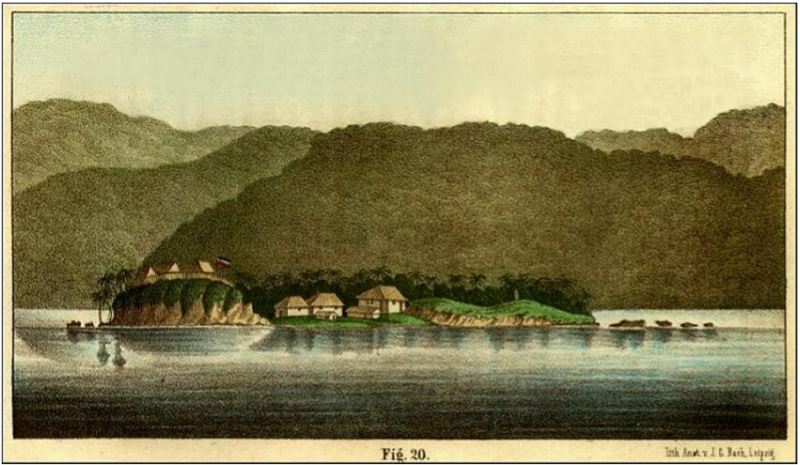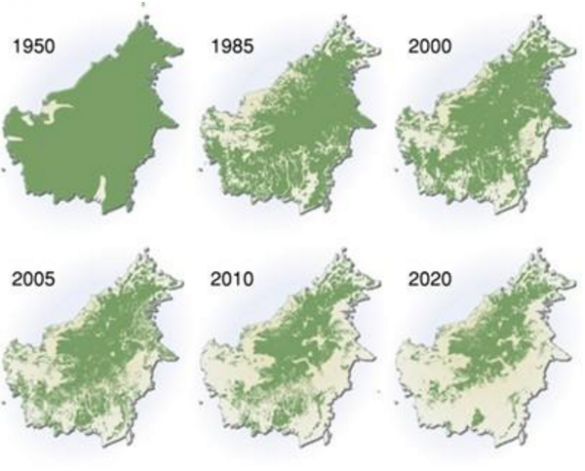Imagine the island of Java in the 1850s. Its lowlands and valleys sparsely populated, dotted with villages, sawah and stands of fruit-bearing trees, its hills and mountain slopes covered in thick tropical rain forests. The outer islands even less populated and virtually forested from coast to coast. Even then a warning voice was already raised. Franz Wilhelm Junghuhn, a German-Dutch medical doctor, geologist and botanist, was fascinated by the constant change he observed in nature. He remarked that processes which took thousands of years to complete were being damaged in a short time by human interference. He noted how deforestation resulted in dried up streams and shortages of water to irrigate the sawah in the lowlands. And in 1856, he advised the colonial government to start a reforestation programme. The same advice is still given now, 150 years later.
In those days, forests covered some 85 percent of Indonesia’s 1.9 million-square-kilometre land area. Its 25 million inhabitants shared their land with tigers (not only on Sumatra but also on Java and Bali), elephants, rhinos, sun bears, clouded leopards and, of course, orangutans. Population densities on the island of Java were higher than on the outer islands, and forests would not have covered more than 50 percent of the island. But still, just outside Bogor (then Buitenzorg) and in the mountains, one would encounter tigers. There was such an ample supply of these that for public entertainment the Yogyakarta palace (Kraton) would regularly stage fights between a tiger and a buffalo. In typical Javanese fashion, the symbolic meaning of these fights was highly appreciated. The tiger, the colonial oppressor, would start off strong, but the determined and steadfast buffalo, representing the Javanese people, would typically be the victor in the end.
From 1850 until now, Indonesia’s forest loss has been calculated by various researchers and organizations. Kees Klein Goldewijk of the National Institute for Public Health and the Environment, based in the Netherlands, and Navin Ramankutty of the Center for Sustainability and the Global Environment at the University of Wisconsin calculated that in the period 1880 to 1980, Indonesia’s forest cover declined from 83 percent of the total land area to 63 percent.


That decline does not appear particularly dramatic. Unfortunately, however, those 100 years are just the run-up to the dramatically increased levels of deforestation of the next 30 years.
Rather than presenting this trend in figures and tables, the following maps of Sumatra illustrate this perfectly. The same exponential decrease also occurred in Borneo (Kalimantan, the Indonesian part, and to a lesser extent also in Malaysian Borneo).
For comparison, the lithograph below, drawn by Junghuhn in 1840, illustrates how a ‘wall-to-wall’ forest cover looks from the sea.
While deforestation caused by logging, legal or illegal, is on the decline in Indonesia due to the introduction of an accurate and strictly implemented control system, deforestation does continue. Forests are being clear-cut and converted to agricultural uses, mainly oil palm and acacia for pulp and paper. And for strip mining, the most common form of mining in Indonesia, even the topsoil is removed after felling the trees.
Indonesia’s forests are obviously not treated as a living organism with interdependent parts but as a mere source of timber and corporate profits. Destruction of one part of the organism has a direct destructive effect on other parts. The tigers, elephants and orangutan are a case in point, as are the indigenous forest dwellers.
Their forests are invaded, clear-cut and burned, and their livelihoods are destroyed together with their socio-cultural heritage.
One group of the indigenous Suku Anak Dalam on Sumatra, for example, lost thousands of hectares of their ancestral land to an oil palm plantation. The three hamlets in which the 82 families had lived for nearly 100 years were bulldozed and the families evicted. The estate claimed that the villagers had no right to the land. The same happened to a Dayak community in Kalimantan who lost 18,000 hectares of sacred forest.
This lack of regard for the rights of the indigenous people is, unfortunately, hampering the efforts to reduce deforestation, as the most qualified guardians of the forests are the indigenous inhabitants. These communities have for generations lived in harmony with their surroundings, and even their use of ‘slash-and-burn’ to clear plots for crop production does not generally lead to uncontrolled fires.
Involving the indigenous groups in the management of forests would require giving them a seat at the table where the policies and strategies affecting the forests are discussed. In fact, not only a seat, but also full information regarding the relevant details needed for the decision-making process, and the right to voice their opinions and concerns. Giving all stakeholders a say is the first step needed to avoid problems such as the ones faced by the groups on Sumatra and Kalimantan.
Full participation of the Indonesian indigenous communities will require a shift in mentality on the part of the companies – the oil palm and pulp forest estates in Indonesia. Their search for a least-cost solution can be understood. But these calculations should, to avoid conflicts, include the cost to the environment and landscapes, as well as the potential reductions in the livelihood and wellbeing of the original occupants of the lands.
Government agencies at Indonesia’s central, provincial and district levels have an important role as moderators and stimulators of discussions to ensure full participation.





